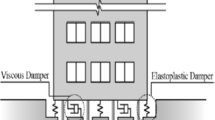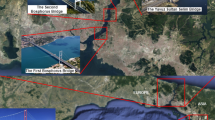Abstract
Oil storage tanks are widely used in petrochemical industry. But the improper foundation treatment is likely to cause the damage of structure and accessory components under the action of earthquake, as a result, environmental pollution and fire will be caused by chemical leakage. Therefore, it is necessary to study the dynamic stability and the security affecting factors of composite foundation. Taking foundation treatment of one oil depot belong to Petro China as the engineering background, the discrete compacted piles arranged by equilateral triangle are simplified by the equivalent continuum method. Contacts are set between pile and soil, between concrete foundation and subsoil, and between concrete foundation and tank to reflect the mechanical behavior of the system as far as possible. The composite foundation with three kinds of area replacement ratios are studied by the dynamic stability analysis. The results show that safety factors corresponding to the three area replacement ratios are all greater than the general safety factor 2 which is required in engineering; the dynamic safety factors increase with the increase of area replacement ratio. Besides, area replacement ratio has a great influence on the distribution of plastic zone. Therefore, in the actual project, taking into account the dynamic safety factor and the distribution of plastic zone, there is an optimal area replacement ratio, and it may not only meet requirements for engineering safety, but make use of materials rationally and increase economic benefits.









Similar content being viewed by others
References
Gong, X.N.: Generalized composite foundation theory and engineering application. Chin. J. Geotech. Eng. 29(1), 1–13 (2007)
Liu, J., Zhou, D.Q., Zhao, M.H.: Nonlinear analysis of the interaction between flexible group piles and the surrounding soil. China Civ. Eng. J. 37(12), 55–61 (2004)
Yang, J., Peng, S.P.: Experimental research on interaction of pile with soil under condition of pile group. Rock Soil Mech. 25(2), 312–315 (2004)
Zou, L.H., Fang, L.Q., Huang, K., Wang, L.Y.: Vibration control of soil-structure systems and pile–soil-structure systems. KSCE J. Civ. Eng. 16(5), 794–802 (2012)
Liu, S., Weng, D.G., Zhang, R.F.: Seismic response simplified analysis of a cylindrical storage tank considering the soil–pile interaction. Chin. Q. Mech. 34(1), 161–168 (2013)
Fattah, M.Y., Salman, F.A., Al-Shakarchi, Y.J., Raheem, A.M.: Coupled pile–soil interaction analysis in undrained condition. J. Central South Univ. 20, 1376–1383 (2013)
Ahmed, A.M., Yasser, K.: Analytical investigation of pile–soil interaction in sand under axial and lateral loads. Adv. Struct. Eng. 6(54), 1–16 (2014)
Ren, C.C., Xu, Z.G., Xiao, C.Z.: Seismic performance analysis of single-column elevated station considering pile–soil interaction. J. Build. Struct. 35(5), 25–32 (2014)
Wu, C.F., Guo, W.C., Li, Y.N., Tie, R.: Calculation of neutral surface depth and pile–soil stress ratio of rigid pile composite foundation considering influence of negative friction. Chin. J. Geotech. Eng. 38(2), 278–287 (2016)
Yan, S.W., Lang, R.Q., Sun, L.Q., Chen, J., Jia, Z.L.: Calculation of pile–soil stress ratio in composite foundation with rigid pile-net based on plate theory. Chin. J. Rock Mech. Eng. 36(8), 2051–2060 (2017)
Liu, H.J., Yang, Z.Q., Wang, X.H.: Study on finite element analyses of differential settlement in soft foundation of large-scaled oil tank. Period. Ocean Univ. China 44(5), 89–94 (2014)
Yang, T., Yin, Z.Z.: Finite element analysis of composite ground based on composite constitutive model. Rock Soil Mech. 19(2), 19–25 (1998)
Gu, C.C., Liu, S.S.: Study of application of cement mixing pile to dike stabilization. J. Disaster Prev. Mitig. Eng. 25(3), 330–334 (2005)
Li, J.C., Li, N.H., Cong, J., Cao, Y.L., Cao, J.: Deformation behaviors and variable rigidity design with equilibrium settlement for CFG pile composite of large storage tanks. Chin. J. Geotech. Eng. 39(11), 1–5. http://kns.cnki.net/kcms/detail/32.1124.TU.20170926.1634.006.html (2017)
Griffiths, D.V., Lane, P.A.: Slope stability analysis by finite elements. Geotechnique 49(3), 387–403 (1999)
Zheng, Y.R., Zhao, S.Y.: Limit state finite element method for geotechnical engineering analysis and its applications. China Civ. Eng. J. 38(1), 91–104 (2005)
He, Q., Wang, D.J., Liang, W.W., et al.: The dynamic stability analysis of pile–net composite foundation. Chin. J. Undergr. Space Eng. 8(4), 761–766 (2012)
Cheng, X.S., Zheng, Y.R., Tian, R.R.: Dynamic finite element strength reduction method of earthquake stability analysis of surrounding rock of tunnel. Rock Soil Mech. 32(4), 1241–1248 (2011)
Xiao, Y.T., Dang, F.N., Liang, X.Z.: Understand about replacement ratio of multi type pile composite foundation. J. Xi’an Univ. Technol. 30(3), 336–339 (2014)
Yan, M., Luo, P.F., Dong, J.X., et al.: Area replacement ratio of composite ground. Geotech. Investig. Surv. 42(9), 30–35 (2014)
Qin, J., Lu, W., Zhu, J.C., et al.: Calculation methods of soil-column area replacement ratio in the composite subgrade. Constr. Technol. 42(Supp.), 104–107 (2013)
Li, L.X., Huang, J.J., Fu, Q.H., Cheng, X.Y., Hu, F.: Centrifuge experimental study of mechanical properties of composite foundation with different replacement rates under additional load. Rock Soil Mech. 38(Supp1.), 131–139 (2017)
Zhu, K., Xu, R.Q.: Influence of different replacement ratios on composite foundation with rigid-flexible piles. J. Harbin Inst. Technol. 41(4), 148–152 (2009)
JGJ79-2002: Technical Code for Groung Treatment of buildings. China Architecture & Building Press, Beijing (2002)
An, M.L., Zhang, D.G.: Technology and Engineering Practice of CFG Composite Foundation, 2nd edn. China Water Power Press, Beijing (2006)
Gong, X.N.: Development of composite foundation and its application to highrise building. China Civ. Eng. J. 46(6), 3–10 (1999)
Zheng, G., Gong, X.N., Xie, Y.L., et al.: State-of-the-art techniques for ground improvement in China. China Civ. Eng. J. 45(2), 127–146 (2013)
Matsul, T., San, K.C.: Finite element slope stability analysis by shear strength reduction technique. Soils Found. 31(2), 59–70 (1992)
Zhao, S.Y., Zheng, Y.R., Deng, W.G.: Stability analysis of jointed rock slope by strength reduction FEM. Chin. J. Rock Mech. Eng. 22(2), 254–260 (2003)
Cheng, X.S., Zheng, Y.R.: Calculation discussion about safety factor of unlined loess tunnel wall rock structure under earthquake. Rock Soil Mech. 32(3), 761–766 (2011)
Liang, M.Y.: Numerical Simulation Analysis of Dynamic Response of the 100,000 Cubic Meter Liquid-Storage Tank. Harbin Institute of Technology, Harbin (2013)
GB50011-2010: Code for Seismic Design of Buildings. China Architecture & Building Press, Beijing (2010)
Acknowledgements
This work was supported by the National Natural Science Foundation of China (Nos. 41674046 and 51768059), and a part of the Major Innovation Projects for Building First-class Universities in China’s Western Region (No. ZKZD2017006).
Author information
Authors and Affiliations
Corresponding authors
Rights and permissions
About this article
Cite this article
Fan, S., Guo, G., Ma, W. et al. Dynamic stability of composite foundation under different area replacement ratio based on intelligent sensing technology. Cluster Comput 22 (Suppl 3), 5931–5940 (2019). https://doi.org/10.1007/s10586-017-1675-9
Received:
Revised:
Accepted:
Published:
Issue Date:
DOI: https://doi.org/10.1007/s10586-017-1675-9




